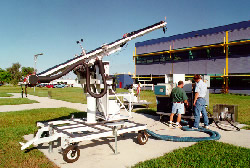
|
|
October 2005 |
New Federal Tax Credits Bring Renewed Interest in FSEC Testing and Certification Program The phones in the offices of FSEC's testing and certification staff members are ringing off the hooks these days. Twenty years after the expiration of federal tax credits for solar thermal systems, the new Energy Policy Act of 2005 will bring the credits back at the start of 2006.
FSEC has tested collectors and systems since the center was created in 1975, and also conducts testing for the national market through the Solar Rating & Certification Corporation's (SRCC) national certification program. "While our testing program has been steady and kept us busy, I've probably gotten more calls since the new energy bill was signed in August than we've gotten in several years," Huggins noted. "It's clear that the solar industry is anticipating a huge increase in sales. Our testing and certification activities will no doubt greatly increase." The new tax incentives, which go into effect on January 1, will give buyers of solar water heating systems a credit of 30 percent, up to a maximum of $2,000. Since solar water heaters are already cost-effective, it's easy to see why the additional incentive of a federal tax credit will give industry sales a big boost. Couple this credit with the many state tax credits, utility incentives and other programs around the country, and the cost of a system becomes very reasonable - and all this at a time when energy costs are on the rise. "What's keeping us especially busy these days," Huggins added, "is that among other activities we're going through a transition right now to international standards. We've always tested to ASHRAE standards, but starting in mid-September, we've changed to ISO (International Standards Organization) standards. It's really a very good move for the solar industry since it will give us more accurate test results for unglazed swimming pool collectors, and it will help U.S. manufacturers keep up with the international market.
When FSEC was chartered in 1975, one of the main missions given the center by the Florida Legislature was to provide impartial third-party testing and certification of all solar water and pool heating equipment and systems sold or manufactured in Florida. Over the years, this important function has helped stimulate a solar industry in Florida that has installed more than 450,000 systems in this state alone. In addition, FSEC's certifications are accepted by a number of states that require the FSEC label before a system can qualify for their state or local incentives. And since 1980, these same procedures have been applied to the national SRCC program. As the country's only solar water heating testing and certification facility, FSEC's label has come to represent the standard of a properly tested and certified collector or system. A staff of six engineers and technicians conduct the testing program. It's an involved procedure that includes the following steps for an active solar collector:
Note that similar procedures are followed for other types of solar equipment, but with variations to account for the system differences. Testing of Integral Collector Storage (ICS) or thermosiphon systems, for example, include some of the above tests as well as a warm-up test measuring the ability of the system to collect solar energy as well as testing of its ability to retain heat. "We're seeing some innovative equipment these days," Huggins said. "New systems include a variety of polymers, roof-integrated mountings, and even hybrid PV-solar thermal units. I've got the feeling we're going to be seeing many new types of collectors and systems that have been developed in recent years and which will be released to take advantage of the new tax credits. The testing and certification program will play an important role in evaluating the efficiency of these new systems. " Huggins also explained that there are many varying procedures for testing complete solar water heating systems. "We do computer models of complete flat-plate solar water heating systems to estimate their performance," he explained. "Our certification actually covers the collector, tank, pump, controller, heat exchanger, piping and insulation, so we look closely at all the components." Detailed information on the various test procedures, a list of approved collectors and systems, and a summary of the new revisions to the standards are available in our Certification and Testing section. |

